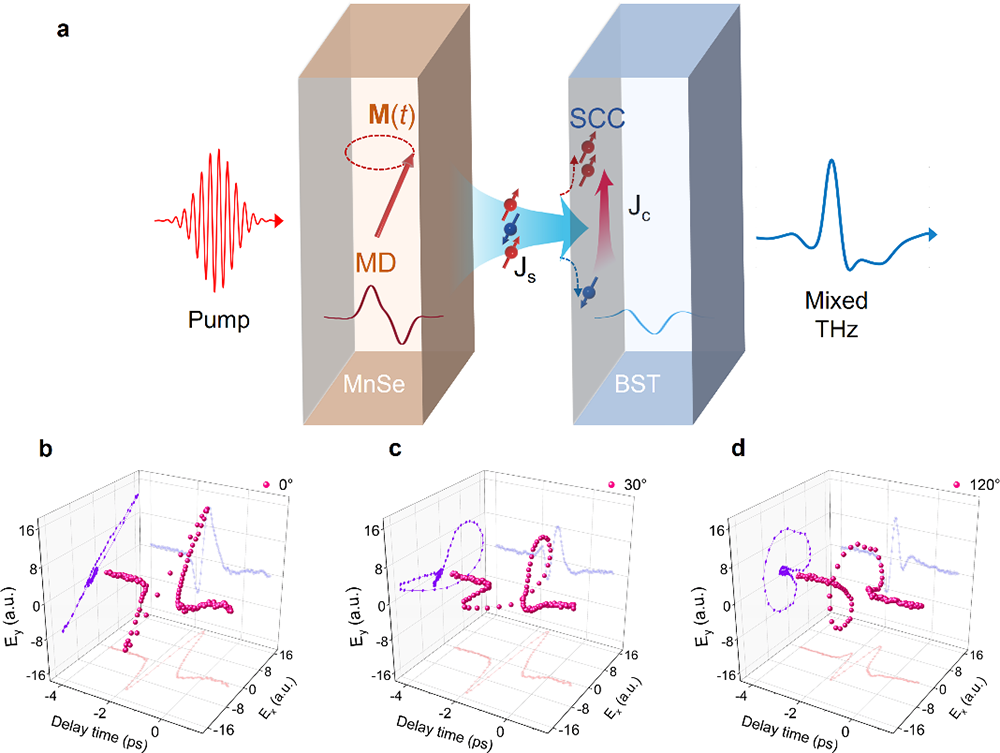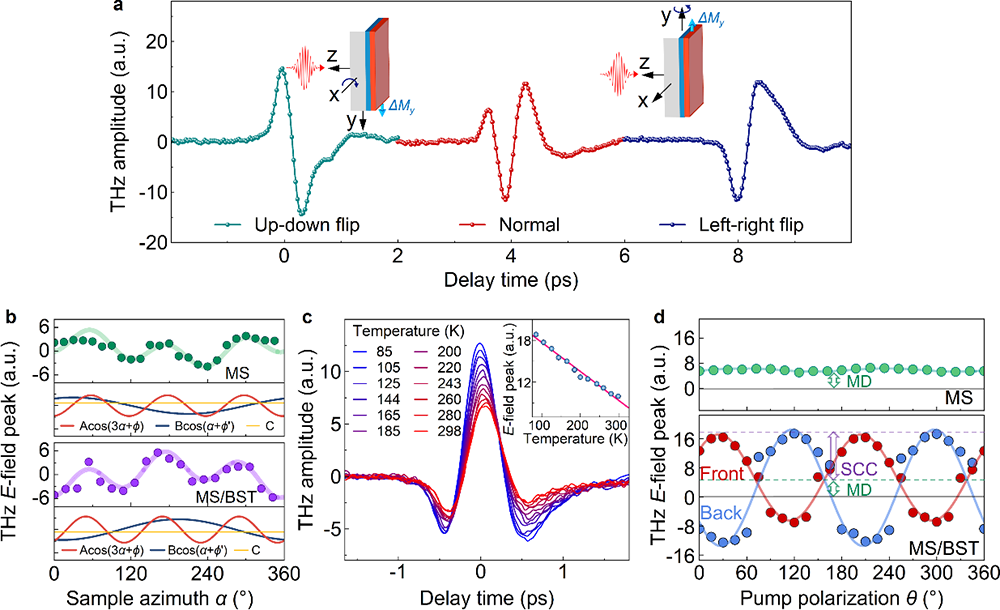Realizing polarization-controllable terahertz generation using antiferromagnet-topological insulator heterostructure
Date:13-08-2025 Print
Spintronic THz emitters, typically designed as magnetic-nonmagnetic thin film heterostructures, have garnered significant attention due to theoretically high near infrared-THz conversion efficiency. Such devices allow spin current generation upon optical pumping, meanwhile convert spin currents into charge currents through mechanisms such as inverse spin Hall effect and radiate THz pulses. Among various material options for spintronic THz emitters, antiferromagnets (AFMs) exhibit high-speed spin response compared to ferromagnets. Topological insulators (TIs), on the other hand, offer larger spin Hall angles than heavy metals. However, AFM-TI structure has never been realized for THz emission or other ultrafast property, due to the lack of proper AFM and TI materials to form a lattice-matched heterostructure.
Recently, Prof. ZHAO Jimin Group (the SF10i Group) of the Institute of Physics, Chinese Academy of Science/Beijing National Research Center for Condensed Matter Physics, in collaboration with Prof. Li Yongqing Group (the N08 Group), Prof. WU Xiaojun Group from the Beihang University, and Prof. Franz X. Kärtner from the university of Hamburg, used the ultrafast THz spectroscopy to investigate the THz emission spectra of AFM-TI heterostructure MnSe/(Bi,Sb)2Te3 under different optical pumping conditions and various temperatures, confirming that AFM-TI heterostructure is an ideal THz emitter with controllable polarization state.
Experimentally, Prof. ZHAO Jimin Group used ultrafast THz spectroscopy to probe the THz pulses emitted from MnSe/(Bi,Sb)2Te3 heterostructure upon near-infrared light pumping. It is observed effective THz radiation at room temperature without auxiliary fields. Through the analysis of pump polarization- and sample azimuth-dependent data, they discovered two interrelated mechanisms: magnetic-dipole radiation and spin-to-charge conversion, which jointly participate in the THz emission process. On this basis, adjusting the pump light polarization angle effectively tuned the ratio of two THz components, thereby controlling the polarization state of the combined THz emission pulses. At specific angles, they obtained near-to-perfect circularly polarized THz emission with practical application value. Their investigation advanced the AFM-TI heterostructure as a new class of polarization-controllable spintronic THz emitters, accomplishing the last piece of jigsaw puzzle of magnetic-nonmagnetic heterostructure-based THz spintronic devices.
This work entitled “Antiferromagnet-topological insulator heterostructure for polarization-controllable terahertz generation” was recently published in Nature Communications 16, 5656 (2025).
This work was supported by the National Key R&D Program of China, National Natural Science Foundation of China, Chinese Academy of Sciences, and Beijing Natural Science Foundation.
The article link is: https://doi.org/10.1038/s41467-025-60060-5

Fig. 1 Control the THz polarization state by adjusting pump polarization. (Image by Institute of Physics

Fig. 2 Distinguish and characterize two THz emission mechanisms. (Image by Institute of Physics)
Contact:
Institute of Physics
Zhao Jimin
Email: jmzhao@iphy.ac.cn
Key Words:
Ultrafast spectroscopy; Spintronic THz emitter; AFM-TI heterostructure; Circular THz emission;
Abstract:
By innovating an AFM-TI heterostructure as a new class of spintronic THz emitters, they succeeded in realizing two-mechanisms THz radiation through ultrafast THz spectroscopy, providing a prominent route of generating polarization-controllable THz radiation.


